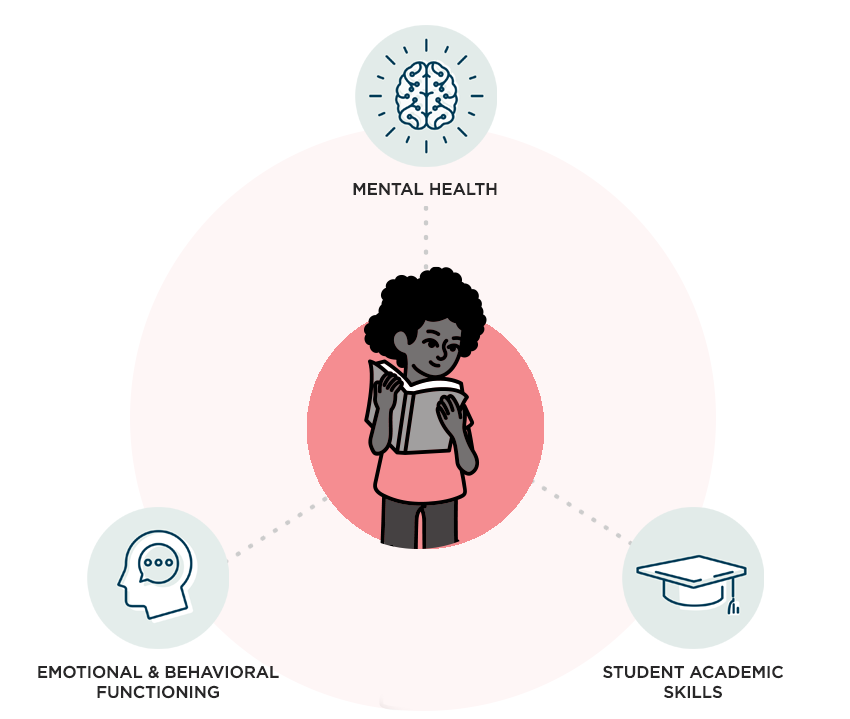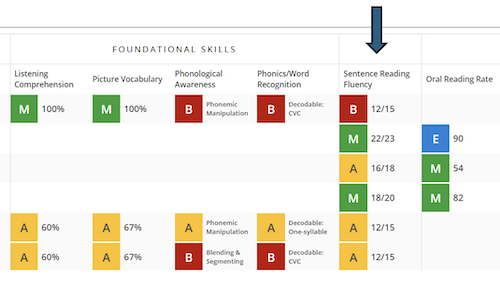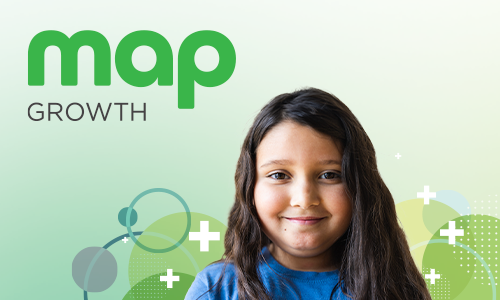 Assessing students’ academic progress is a cornerstone of effective education. Assessments can offer critical insights into students’ learning needs. They can help teachers plan and differentiate instruction, and they can help school leaders identify students who need extra support or enrichment. Universal screening plays a vital role in a balanced and comprehensive assessment system.
Assessing students’ academic progress is a cornerstone of effective education. Assessments can offer critical insights into students’ learning needs. They can help teachers plan and differentiate instruction, and they can help school leaders identify students who need extra support or enrichment. Universal screening plays a vital role in a balanced and comprehensive assessment system.
The idea of universal screening seems very straightforward: all students take the same test so educators can see where each student stands academically. But there are a lot of important questions to consider even before students sit down to take the test. When should students be screened? What are they being screened for? What should be done with the results? Can a different assessment be used as a universal screener?
In this article, I’ll dig into what universal screening is and how school leaders can use it effectively. A solid understanding of these assessments can go a long way toward helping leaders make informed, purposeful decisions, especially because decisions about screening often involve tradeoffs. Let’s dig in!
A quick guide to terminology
Universal screening assessments are a key part of multi-tiered systems of support (MTSS) and response to intervention (RTI) systems, along with diagnostic assessments and progress monitors. There’s often uncertainty about the role of each component, so here’s a quick guide.
 What is a universal screener?
What is a universal screener?
A universal screener is an assessment given uniformly to a class, school, or district, generally as part of an RTI (response to intervention) or MTSS (multi-tiered system of supports) system, for the purpose of identifying when students are at risk of learning challenges or disabilities that would prevent them from succeeding in the general education curriculum, or when they would benefit from more challenging material than what is currently being offered.
What is a diagnostic assessment?
A diagnostic is a more detailed assessment given to a smaller group of students that provides educators with actionable data about students’ strengths and areas for growth in a specific skill area. Diagnostic assessments are often used for determining the root cause of the area for growth identified by a universal screener.
What is a progress monitor?
Assessments that provide data about the effectiveness of instruction or the interventions educators have implemented based on data from a universal screener or diagnostic assessment are called progress monitors. They include formative assessment and interim assessments.
More on what universal screeners can do
Imagine a tool that can help teachers know how well their students are doing and identify anyone who needs extra support—for their health and well-being, academic learning, or even behavioral needs. This is what universal screeners are designed to do.
You can think of a universal screener as a quick check-up for every student in a class, school, or district. Based on the check-up, you’ll have a good sense of students’ strengths and areas for growth. You’ll know which students need extra help, which students will do well with standard instruction, and which students could benefit from greater challenge.
Universal screeners for academic subjects like reading and math are much like the health screenings we routinely give students for vision and hearing. If the results of these screenings show that a student is likely having trouble seeing the board or hearing the teacher, the student can be given glasses or hearing aids. Or the school can make changes to improve the learning environment, such as seating a student closer to the teacher or using large fonts for any visual displays.
Another example of a universal screener that most people are familiar with is being screened for a fever when you visit the doctor. Having your temperature taken at the doctor’s office is considered routine, and for good reason: a fever is a signal that something is wrong with your body and more investigation is needed. Similarly, a universal screener designed to assess academic ability can signal when students are at risk of learning challenges or disabilities. By identifying students with the greatest risk of poor educational outcomes, schools can provide the resources students need to succeed.
However, just like a fever cannot tell a doctor exactly what is wrong with a patient, a universal screener cannot pinpoint the specific cause of a student’s learning challenges. That is where diagnostic testing comes in. A doctor typically orders tests or uses other diagnostic tools to figure out why a patient has a fever. Similarly, diagnostic tests for reading or math skills can be used to identify the root cause of a student’s academic difficulties.
Universal screeners in medicine are often good at identifying health problems and chronic diseases. However, practitioners sometimes treat the symptoms of risk (e.g., the fever and sore throat) rather than the underlying issue. And while giving a fever reducer can temporarily alleviate the symptoms of a fever, it cannot pinpoint what illness is causing the fever. Similarly, in education, when we give a student extra practice or support without identifying the root cause of their academic challenges, it may not lead to long-term improvement.
In our medical scenario, once the doctor has gathered more information and prescribed treatments, it’s important to assess the outcome of the treatments. Did they work as expected? In education, this is why interim assessments are often a popular choice for universal screening. Not only are they useful tools for identifying students who may need different supports, but they’re also good at measuring the general outcomes of the treatment over time. This is why universal screening and diagnostic testing should be used together. When done effectively, they can support students with successful interventions targeted at root causes rather than just the symptoms of their academic challenges.
The graphic below shows how universal screening and diagnostic testing work together and complement one another in a balanced and comprehensive assessment system. Universal screening casts a wide net to identify students who may need additional support, while diagnostic testing targets a smaller group for more detailed evaluation.
![]()
The characteristics of a good universal screener
Good universal screeners share a few key qualities.
Cost
A good universal screener should use no more resources than necessary.
Alignment
A good universal screener should be aligned in content, domain, and level with the district services into which students will be placed.
Sensitivity
A good universal screener should correctly catch students who would benefit from the service.
Access
A good universal screener should remove any implicit or explicit barriers that are unrelated to need for or success in the service, ensuring that the focus remains on each student’s actual educational needs and potential for success.
Clarity of purpose
Universal screeners should provide clarity, especially in terminology, about what they are screening for.
When should you use a universal screener?
School leaders must be clear and intentional about the question they want a universal screener to answer. Is the goal to predict which students are at risk for academic failure? Or is it to identify students who would most benefit from a talented and gifted program? If a universal screener is good at answering these specific questions, it can be an effective and efficient screener. Schools interested in screening for reading difficulties might use an assessment like the Dynamic Indicators of Basic Early Literacy Skills (DIBELS). Or they might administer the Screening Test for Number Sense (STeNS) for assessing early math skills. These are just two examples, and the chosen screener should align closely with a school’s goals and their students’ needs.
Individual states often have requirements for which students should take a universal screener and how often they should take it. For example, many states are focused on early literacy and require students to be screened multiple times per year in the early elementary grades.
What are the benefits of universal screening?
When universal screeners are given universally and interpreted accurately, they can help promote equity, support student success, and foster a culture of data-informed decision-making. Beyond this, some key benefits are listed here.
Early identification of learning needs
Universal screeners help identify learning gaps, social-emotional learning (SEL) needs, language proficiency levels, and other issues early on, allowing educators to address these areas proactively and provide appropriate support to students.
Personalized learning and targeted interventions
By identifying potential problem areas or opportunities for acceleration for individual students, universal screening encourages the creation of supports that can meet a student’s unique needs.
Improved educational outcomes
Personalized interventions, based on universal screener results, better equip students to succeed academically, leading to improved educational outcomes and overall student achievement.
Role in RTI/MTSS frameworks
Universal screening is a foundational component of RTI and MTSS frameworks. These approaches are designed to proactively identify students who may need additional support before their issues become more significant. This kind of early identification of (and support for) students who may require additional interventions leads to better outcomes. Universal screening can provide the data necessary for proactively identifying these students and monitoring their progress over time.
Grade-level considerations
While the core principles of universal screening remain consistent across grade levels, screeners may vary in their design and focus based on the needs of students at different developmental stages. Screeners for lower grades may emphasize foundational literacy and numeracy skills, for example, while those for middle and upper grades may assess more advanced concepts.
Consistent comparisons
Universal screening is often used for making comparisons across classrooms, buildings, and implemented curriculum. While a unit test in an individual classroom can provide data on what students have been taught, a universal screener across multiple classrooms and/or buildings can provide external validation that teaching is having an impact. They are also very important for ensuring decisions about needs are consistent across all students and made without assumptions, supplying objective criteria for providing additional resources.
Streamlined decision-making
By identifying students with specific needs and providing data-driven insights, universal screeners facilitate more informed decision-making for educators. This includes identifying students who require additional support, allocating resources strategically, and monitoring the effectiveness of interventions to make adjustments when needed.
The do’s and don’t’s of universal screening
School leaders and teachers can get the most out of universal screening by keeping some practical guidelines and best practices in mind.
Do regularly review and analyze assessment data
Universal screeners are usually administered to an entire student population at once. They are often given to students at least annually, ideally at the beginning of the school year. The data from this assessment helps educators identify students who may need additional support early in the year, when their needs can be addressed with minimal disruption to the student and the classroom. Many educators who use interim assessments for screening find them to be most useful when they’re given three times a year: in the fall, winter, and spring. This schedule gives teachers the opportunity to compare data and to continually monitor and adjust their interventions based on what they are seeing in the interim assessment screening results. It can also be appropriate to screen new students when they enter a school or district to assist in placement and support decisions, especially if student records don’t include recent data.
Do use results to inform instructional strategies
A universal screener can help schools and teachers make data-driven decisions about how to intervene for those students who aren’t making adequate progress in the core curriculum. For example, universal screeners can identify students at risk of reading difficulties, including dyslexia. Equipped with this information, teachers can adjust their teaching to provide explicit instruction in phonemic awareness and phonics for students with moderate to high risk for dyslexia. The school may provide push-in support with an instructional aide, personalized tutoring, or other interventions to buoy the teachers’ instructional efforts.
Do dig deeper when necessary
It’s important to keep in mind that universal screeners are one piece within a balanced and comprehensive assessment system, one that includes diagnostic assessments. The diagnostic assessments can be used alongside universal screeners to identify a student’s strengths and areas for improvement in specific skill areas so teachers can provide the student with the most effective intervention.
Do match your purpose to the appropriate assessment tool
If the goal is to help students with discrete, skill-specific interventions, a diagnostic assessment is the best tool. For identifying students’ strengths and areas for growth, an interim assessment is often the best option.
Do collaborate with colleagues
A professional learning community (PLC) is the perfect forum for educators to collaborate around universal screeners. By sharing strategies, analyzing student data, and discussing best practices, teachers can improve student outcomes while refining their assessment skills. Highly effective districts also often group teachers, administrators, data specialists, interventionists, and others to collaboratively review data and create aligned plans for intervention.
Don’t implement a one-size-fits-all approach to interventions
English learners (ELLs) may be identified by a universal screener as needing support. But different ELLs have different levels of English proficiency. Some may need basic language support while others might require more advanced academic language instruction.
Imagine a student whose assessment revealed a moderate to high risk for dyslexia. This student would also likely have trouble with comprehension. Perhaps the assessment of another student in the same class revealed they are also having difficulty with comprehension. Should we group these two students together? We could, but individually targeting each student’s intervention would likely produce better outcomes. We would intervene for the second student by targeting their ability to understand and engage with the text, which is different from the explicit instruction in phonemic awareness and phonics needed for our student at risk for dyslexia, even though both students need extra support with comprehension.
A one-size-fits-all approach never really fits “all.” Districts with a mature and robust intervention approach have often pooled a bank of evidence-supported strategies they can prescribe to individuals or groups of students based on what they know about the students from multiple data sources.
Don’t neglect ongoing professional development for teachers
A recent survey found that 48 percent of teachers said the professional development they are required to take is irrelevant or not connected to their current teaching job. Even more alarming was the fact that the overwhelming majority of administrators—84 percent—said this same professional learning was on target. The takeaway here is to engage deeply with your staff to understand what professional learning would drive growth for both teachers and students. Just like we tailor our supports to students, teachers benefit when administrators thoroughly understand their learning needs and provide individualized supports to advance their teaching practice.
What are the limitations of universal screeners?
A reliable and valid universal screener is a powerful tool for quickly identifying students who may need extra support. But, like any tool, they have limitations. Understanding those limitations can go a long way to helping teachers interpret the resulting data.
Universal screeners are not exhaustive diagnostics
Universal screening can determine which students are in need of specific types of support and the types of support that would help them on their way toward grade-level goals. At-risk students are then often placed into short-term interventions. Diagnostic assessments go much deeper, uncovering the why behind each student’s specific challenges. That’s why they should ideally be used together with a universal screener.
The results of universal screeners should be considered as one of many data points
Teachers often use universal screening results in combination with formative assessment while considering the individual student’s background, learning environment, and cultural factors, among other things, to get a more comprehensive understanding of their strengths and areas for support.
The potential for cultural and linguistic bias is always an issue
These challenges are of course not unique to universal screening, but educators should be aware that students may encounter difficulties with the assessment itself, as opposed to the content of the assessment. Assessments may include content that reflects the experiences and knowledge of the dominant culture, for example. This can put students who are not familiar with certain references at a disadvantage. Misunderstandings and misinterpretations are possible when universal screeners are administered in a language other than a student’s first language. This is especially true for English Language Learners (ELL). Universal screeners can also be normed on populations that don’t reflect your student body. This can produce results that don’t accurately reflect the abilities of your students from different cultural and linguistic backgrounds. Consider using local performance standards or cut scores to make sure your students qualify for the right supports.
Overemphasizing standardized testing can be problematic
Standardized test scores can be influenced by outside factors like student stress, hunger, and fatigue. Results from a test can negatively impact a student’s mental health and overall well-being. These are just two reasons formative assessment is such a crucial piece to be used alongside universal screeners in a balanced and comprehensive assessment system. A standardized test score is a critical indicator, but it does not tell the whole story.
Implementation fidelity and implementation integrity are important considerations
There is often a notable difference between how an assessment is designed to be administered and how it is actually administered.
Implementation fidelity is the degree to which the assessment is delivered as it was originally designed. For example, it’s important for a universal screener to be administered consistently across different sessions and groups of students. This includes following the same procedures, instructions, and timing to ensure that all students have an equal opportunity to demonstrate their abilities. Otherwise, it would be impossible to make apples-to-apples comparisons between students.
Implementation integrity involves making thoughtful adjustments to the process that respect the underlying goals and principles of the assessment while addressing the unique needs and circumstances of your students. Offering language support for your ELLs, such as providing instructions in their native language or using bilingual proctors, can help ensure language barriers don’t affect the accuracy of the assessment, for example.
One of the main goals of a universal screener is to provide educators with results that can be interpreted in the same way for all students. For example, if a district with a majority of ELLs administered their universal screener with strict fidelity, their overall results may suggest significant problems for those students, problems that would not have surfaced with the implementation integrity adjustments we mentioned.
Comparing universal screeners
In RTI and MTSS settings, the two main areas you will typically see universal screeners assess are student academic skills and behavior and emotional functioning. (The National Center on Intensive Intervention, or NCII, provides ratings of academic and behavior screening tools). Mental health screeners also provide valuable information.
 Academic skills
Academic skills
When we think of a universal screener in K–12 education, this is most likely what comes to mind. Academic universal screeners assess students’ proficiency in core academic areas such as reading and math.
- Reading. Strong reading skills are foundational for success in other academic areas. By identifying specific areas for growth, such as phonemic awareness or comprehension, teachers can provide targeted support and instruction tailored to each student’s needs. As we mentioned before, educators might use the K–8 DIBELS (Dynamic Indicators of Basic Early Literacy Skills) assessment or MAP® Reading Fluency™ to screen students in reading. In general, a good universal screener for K–12 reading should assess student progress in phonemic awareness (understanding and manipulating sounds in words), phonics (recognizing the relationship between letters and sounds), fluency (reading with speed, accuracy, and proper expression), vocabulary (understanding and using a wide range of words), and comprehension (understanding and interpreting what is read).
- Math. A popular choice for assessing early math skills is the Screening Test for Number Sense (STeNS) or MAP® Growth™. For K–12 students, a good universal screener of math skills assesses number sense (understanding numbers and their relationships), operations (addition, subtraction, multiplication, and division), algebraic thinking (recognizing patterns and understanding algebraic concepts), geometry (understanding shapes, sizes, and the properties of space), and measurement and data (understanding and using units of measure, and interpreting data).
Behavioral and emotional functioning skills
Assessing students’ behavioral and emotional functioning is just as important as measuring their academic progress. Behavioral and emotional challenges often affect academic performance in school, so early identification of these issues is essential for providing the support that can make a difference. The FAST Social, Academic & Emotional Behavior Risk Screener (SAEBRS) is a popular screener for this purpose.
These are the areas that K–12 behavioral and emotional functioning screeners should assess:
- Behavioral risk. Evaluates externalizing behaviors such as aggression, hyperactivity, and conduct problems.
- Emotional risk. Assesses internalizing behaviors like anxiety, depression, and withdrawal.
- Social skills. Measures students’ ability to interact positively with peers and adults.
- Adaptive skills. Looks at students’ ability to adapt to changes and manage daily activities effectively.
- Self-regulation. Assesses students’ ability to control their emotions and behaviors in different situations.
- Personal adjustment. Evaluates overall emotional well-being and personal adjustment to school and social environments.
Mental health screeners
Whereas behavioral and emotional functioning screeners are more focused on day-to-day behaviors and emotional responses, mental health screeners are geared toward identifying clinical mental health issues. The focus is on diagnosing or flagging potential mental health concerns that may require further evaluation and intervention by mental health professionals.
Evaluating the effectiveness of universal screeners
It can be very difficult to compare the many different universal screeners that are available for K–12 students. But by far the most important factor to consider is the effectiveness of a universal screener. If educators don’t trust the results of a particular screener, there is no point in screening students.
When evaluating the effectiveness of a particular screener, there are four areas to consider:
Does the assessment design match your purpose?
Scores on a universal screener must be strongly correlated with the actual placement criteria. For example, requiring students to do extensive reading on a math screener can certainly produce scores that aren’t representative of their achievement in math. The best data points for informing placement in a program or service are those that measure the prerequisite skills necessary to benefit from that program or service.
Does the assessment have a high classification accuracy?
Classification accuracy refers to how well scores on a screening assessment correctly identify students who would benefit from more targeted resources versus those who would not. It is usually expressed as sensitivity (how well the screener correctly identifies students who are at risk/true positives) and specificity (how well it correctly identifies students who are not at risk/true negatives). The NCII recommends that universal screeners have a sensitivity rate of 70 percent or higher and a specificity rate of at least 80 percent.
Does the screener provide real-time, actionable data to educators?
Time is always of the essence. A good universal screener should provide immediate feedback that allows teachers to quickly identify students in need of intervention so they can take the next appropriate step. If we think back to our medical example, a fever—as measured orally with a thermometer—is 100.4°F or above. A doctor treating a patient with a fever would have the results from a tool that quickly provides the necessary data (100.4°) presented on a well-understood scale (degrees Fahrenheit) in a clear way (usually as a digital number displayed on a forehead thermometer). Similarly, any reports generated by a universal screener should be easily understandable and available quickly.
Is the screener backed by rigorous research?
If a screener is evidence-based and has been proven to be both valid and reliable through extensive high-quality research, educators can trust that the results are accurate. Research-backed screeners can also be an important part of the school-home connection, reassuring caregivers that the tools being used to identify next steps for their children are proven to be effective and beneficial for their child’s development.
What are the benefits of using MAP Growth and MAP Reading Fluency for universal screening?
Both MAP Growth and MAP Reading Fluency are great choices for universal screeners. Both are highly rated by NCII for classification accuracy and are backed by our proven record of supporting the critical work of educators across the globe through groundbreaking educational research, assessment methodology, rigorous content, and psychometric precision. Each assessment is used for a different purpose, so we’ll look at them individually.
MAP Growth as a universal screener
Many educators use MAP Growth K–12 as their universal screener because it spans so many subjects and is dependable for identifying overall academic strengths and areas for improvement. MAP Growth also has some groundbreaking new capabilities that promise to make a real difference in the lives of students and educators.
Here are the main reasons it is such a good choice.
- Highly valid and reliable data. MAP Growth is highly rated by the NCII and other third-party studies. The rigorous process for constructing each item, the unmatched depth of the item pool, and the robust national norms all contribute to the accuracy of the percentiles and the assessment’s strong validity in math, reading, language usage, and science. The adaptive nature of the test ensures that each student receives questions tailored to their current level of understanding, which contributes to the precision of the results. The validity and reliability of the data helps educators make informed decisions about instruction and intervention. Additionally, the data can be tracked over time to monitor student progress and growth and adjust when necessary.
- Broad applicability and grade coverage. MAP Growth supports growth for more students in more grades across more subject areas than any other assessment provider. As a universal screener, it covers the widest range of subjects, including mathematics, reading, language usage, and science, and supports students from kindergarten through twelfth grade. There are also extensive options for testing in Spanish. This broad applicability allows schools to implement a consistent assessment system throughout a student’s complete academic journey. MAP Growth assessments are aligned to specific state standards and grade-level expectations, ensuring precise relevance to the local educational requirements of any district.
- Cut scores. MAP Growth includes extensively researched cut scores that are also closely linked to performance on state summative tests. By comparing individual student scores to these cut scores, educators can quickly and accurately identify students who are performing below or above expectations in various grades and subjects. This information is crucial for designing the targeted interventions and enrichment programs that can address diverse student needs.
- Correlation with other criteria. MAP Growth scores are strongly correlated with many eligibility criteria for advanced learning opportunities, making it very useful for placement decisions. The assessment’s predictive validity means that high scores on MAP Growth indicate readiness for more challenging coursework or gifted programs. This correlation helps educators make evidence-based decisions about student placement, ensuring that students are appropriately challenged and supported. The data can also be used to identify students who may benefit from accelerated learning paths or specialized instruction.
- Efficiency. For the many districts that already use MAP Growth, there’s no additional time or resources required because the tests they are already giving will provide the data necessary for universal screening. This efficiency reduces the burden on school staff and minimizes disruptions to instructional time. There’s also no need for extensive data analysis. The comprehensive reporting features of MAP Growth provide educators with clearly presented data that points to actionable insights, streamlining the process of identifying and addressing student needs.
- Linked intervention/instruction. MAP Growth has always linked to a wide range of instructional providers, allowing educators to use the tools they most likely already have to move students forward. Educators now have two more options: HMH Personalized Path uses MAP Growth data to place students in their own unique learning paths, providing targeted intervention and practice for learners across Tiers I, II, and III. And Performance Suite delivers on the promise of “effective whole-class instruction across every classroom in the district” by linking HMH’s deeply researched core instruction with MAP Growth.
MAP Reading Fluency as a universal screener
MAP Reading Fluency primarily assesses foundational reading skills and oral reading fluency, plus literal comprehension. Students in pre-kindergarten through fifth grade are the typical group working on these skills, though some students require sustained support to develop fluency across later grades. Assessing fluency development throughout the elementary years—and intervening when necessary—is a crucial step in supporting today’s young readers.
MAP Reading Fluency offers many important benefits for educators and students:
- Comprehensive data. MAP Reading Fluency provides a complete picture of early literacy by measuring reading fluency and foundational skills so educators can tailor interventions to address specific areas of need. This holistic approach ensures that no aspect of a student’s reading development is overlooked and helps to create a more balanced and effective literacy program.
- Efficiency. MAP Reading Fluency can assess an entire group of students, however large or small, in about one class period. This allows teachers to quickly identify students who need additional support without taking away significant instructional time. Moreover, the streamlined process helps maintain student engagement and minimizes disruptions to the daily classroom routine.
- Early identification. MAP Reading Fluency includes a dependable dyslexia screener, which helps identify students at risk of reading difficulties early on. Early detection of dyslexia and other reading challenges allows for timely intervention, which has been proven to improve long-term academic outcomes. Identifying these issues early can also reduce the emotional and social impact on students since they can receive the necessary support before falling significantly behind their peers.
- Adaptive technology. The assessment uses speech-recognition technology and automatic scoring, ensuring accurate and reliable results. This advanced technology eliminates clerical errors and provides consistent scoring across different students and settings. It’s also a huge time-saver for teachers. Finally, the adaptive nature of the technology means MAP Reading Fluency can adjust to each student’s reading level, providing a personalized experience that accurately reflects their abilities.
- Support for diverse populations. MAP Reading Fluency is available in both English and Spanish. The Spanish option supports non-English-speaking students who receive reading instruction in Spanish. This support also allows students to demonstrate their reading ability in their home language to help inform instructional needs as they acquire English.
- Connected intervention. With the addition of Coach, MAP Reading Fluency’s AI-powered tutor, students can now be placed directly into interventions based on their assessment results. Coach provides in-the-moment microinterventions as students read aloud, ensuring they get the personalized support that will move them forward. Coach not only saves teachers a significant amount of time but has also been proven to double reading growth.
In closing
Universal screening is essential when administered thoughtfully, providing a quick and efficient way to assess all students and identify those who may need additional support or enrichment. It plays a crucial role in multi-tiered systems of support (MTSS) and response to intervention (RTI) frameworks, ensuring that students can receive timely and targeted assistance.
It’s also important to understand the limitations of universal screeners and to use them in conjunction with diagnostic assessments to identify and address the root causes of academic challenges, instead of just the symptoms. Implementing universal screeners with fidelity and integrity, while also considering cultural and linguistic factors, can lead to more accurate and actionable data and ultimately support the success of all students.
You can learn more about MAP Growth and MAP Reading Fluency on our website.





